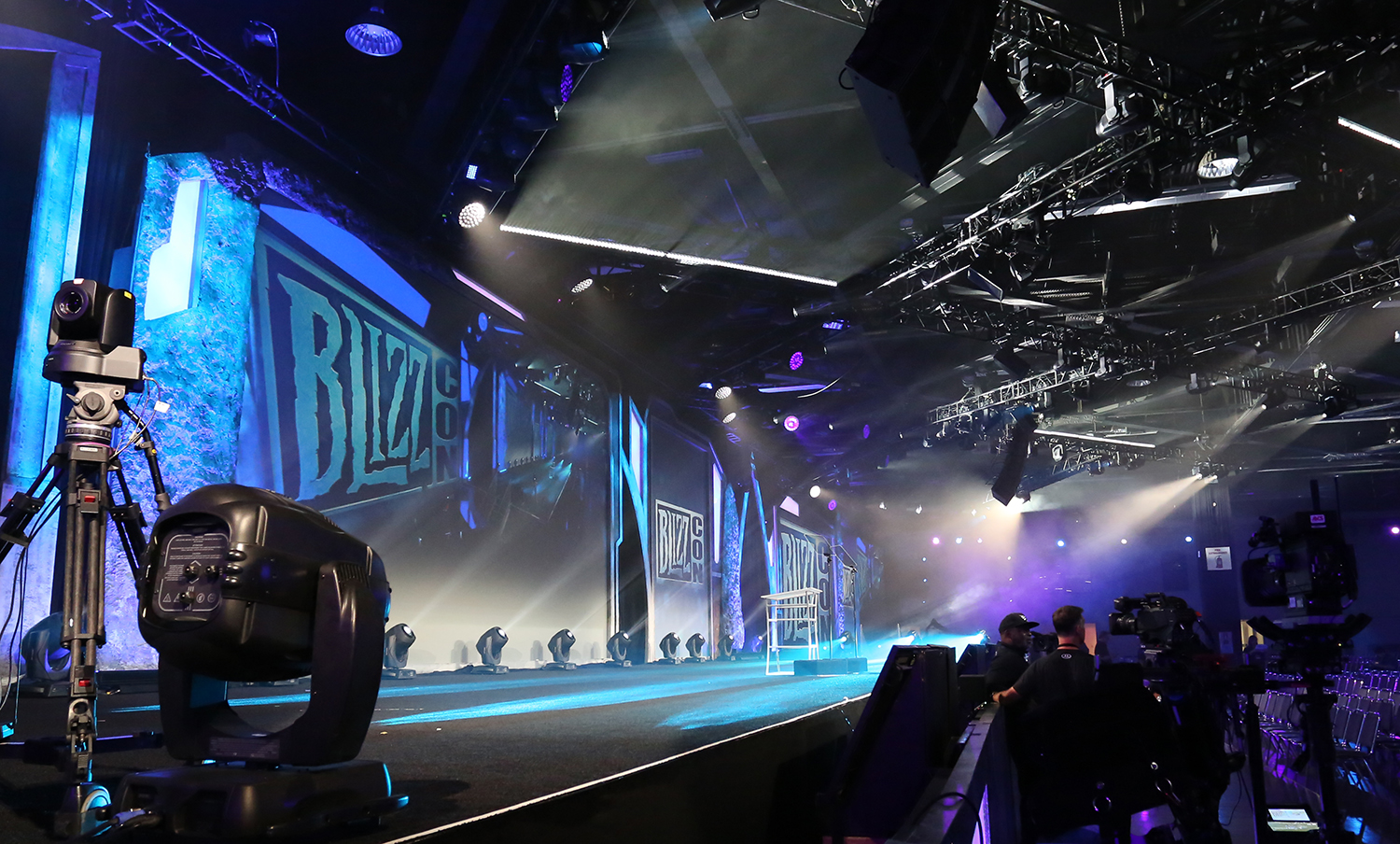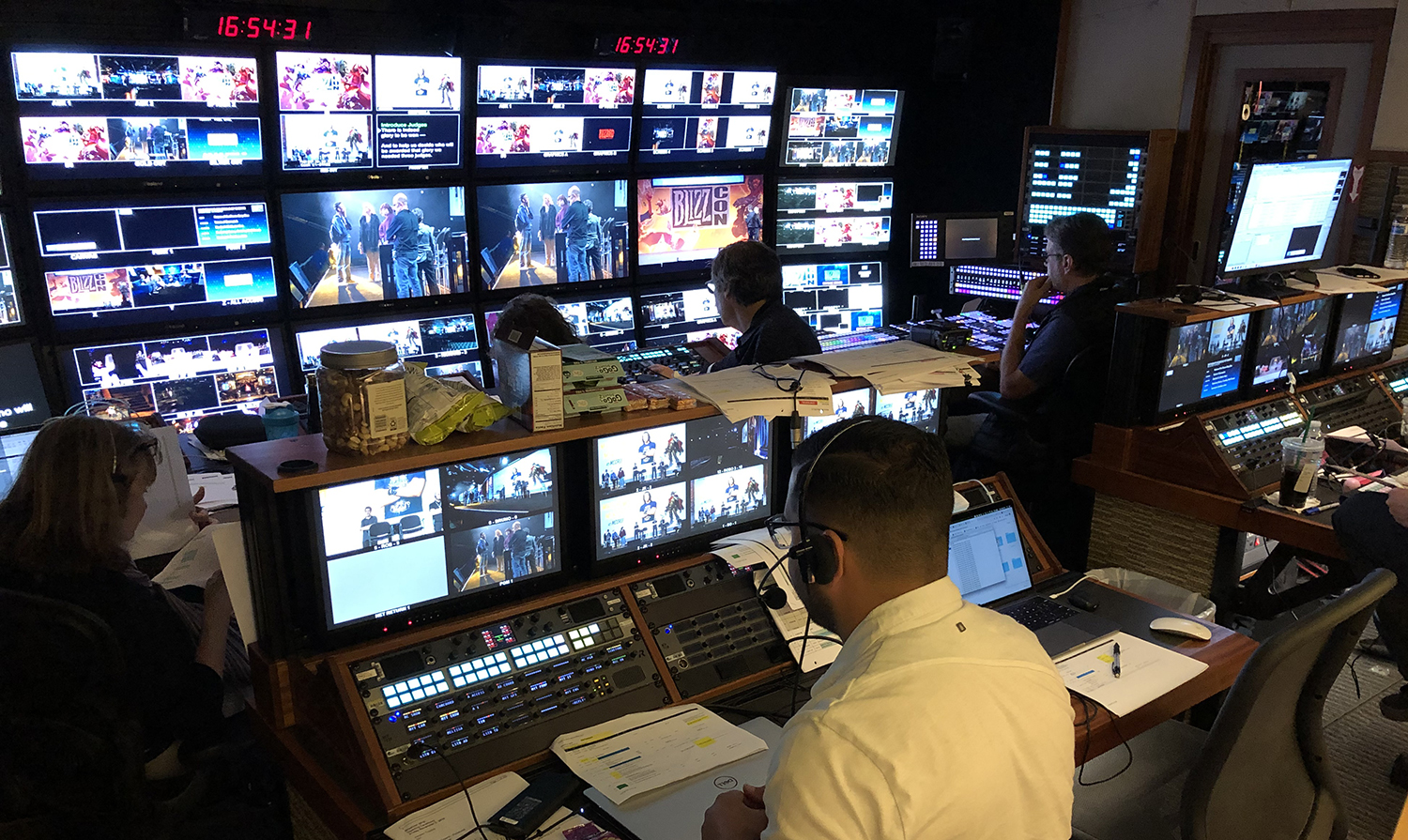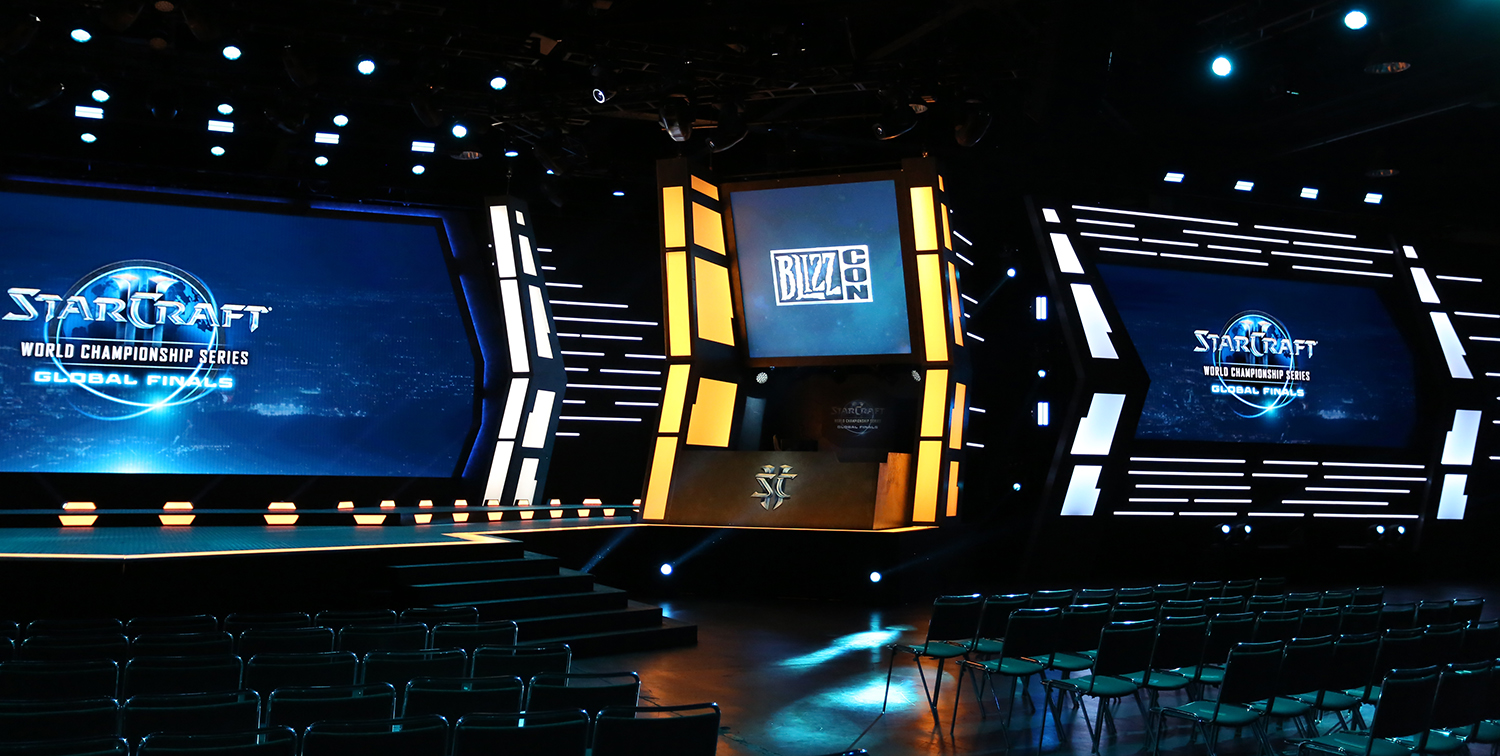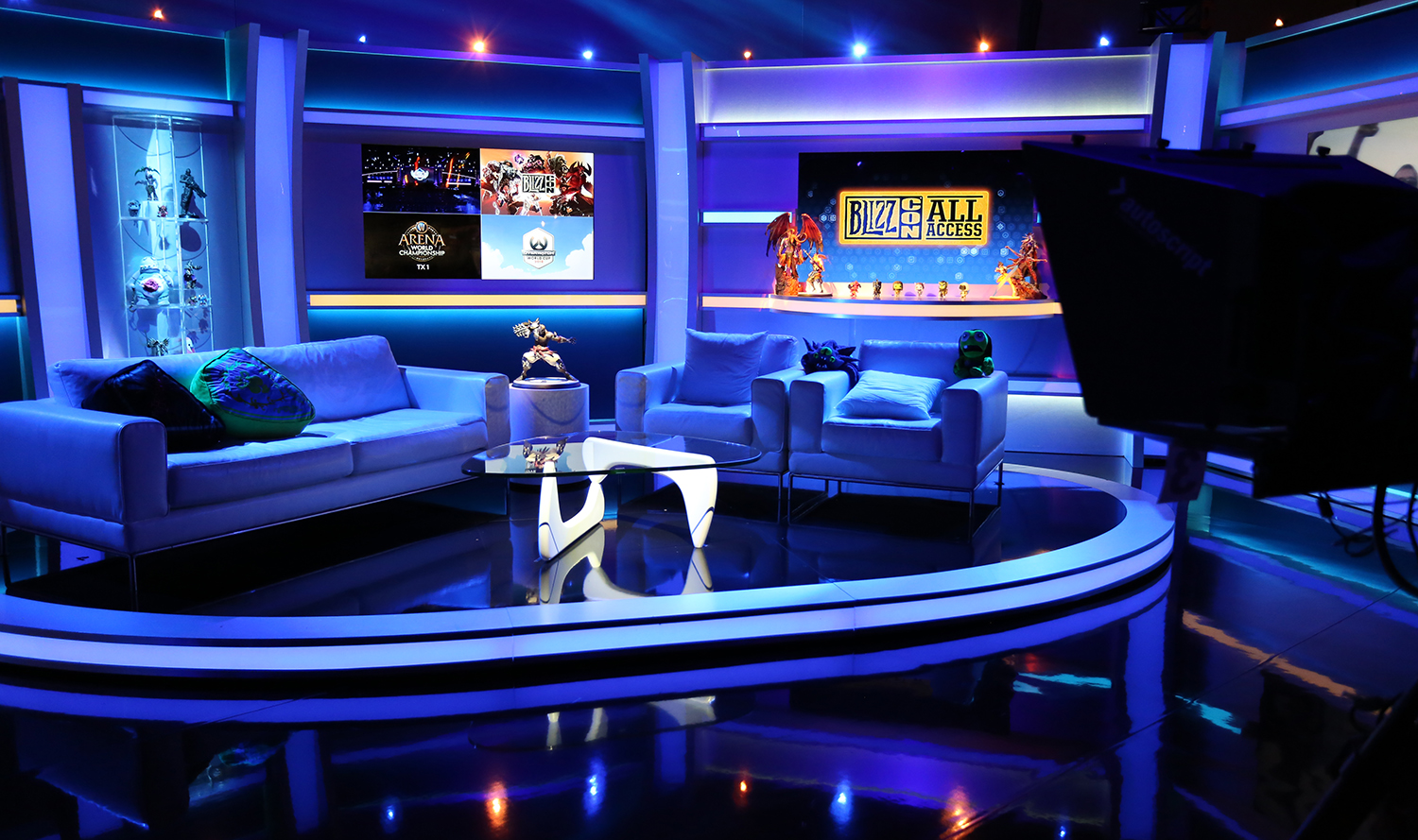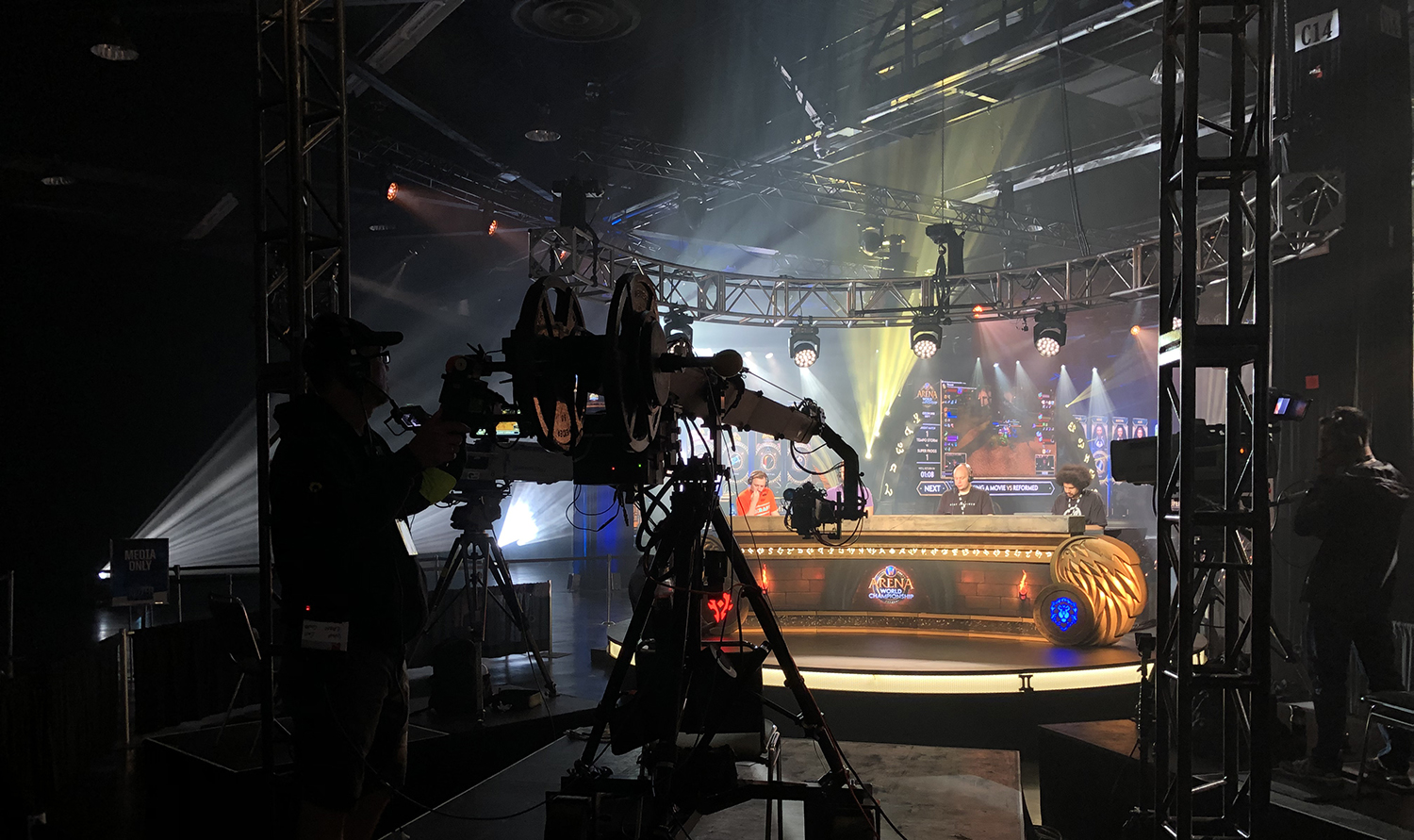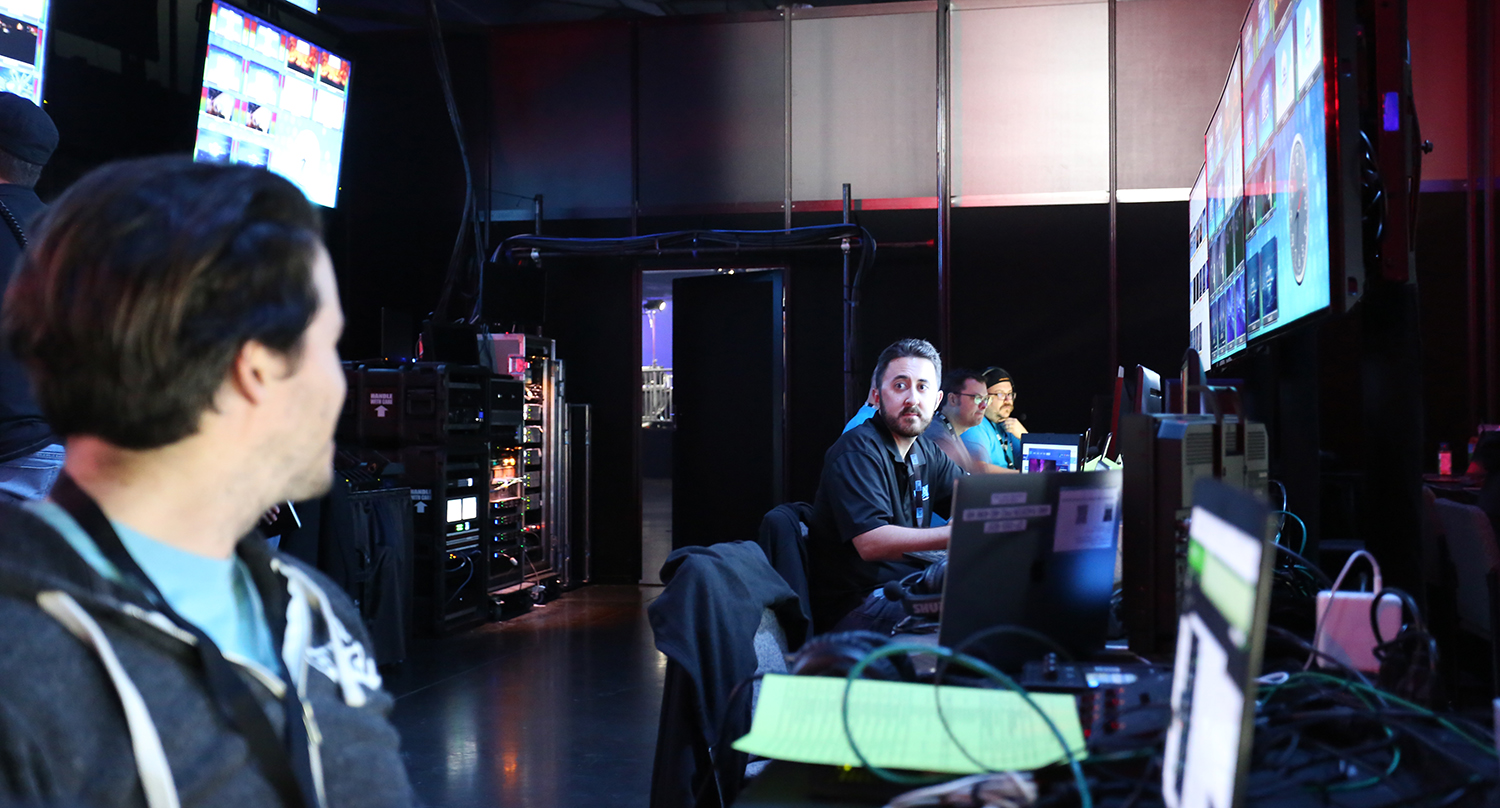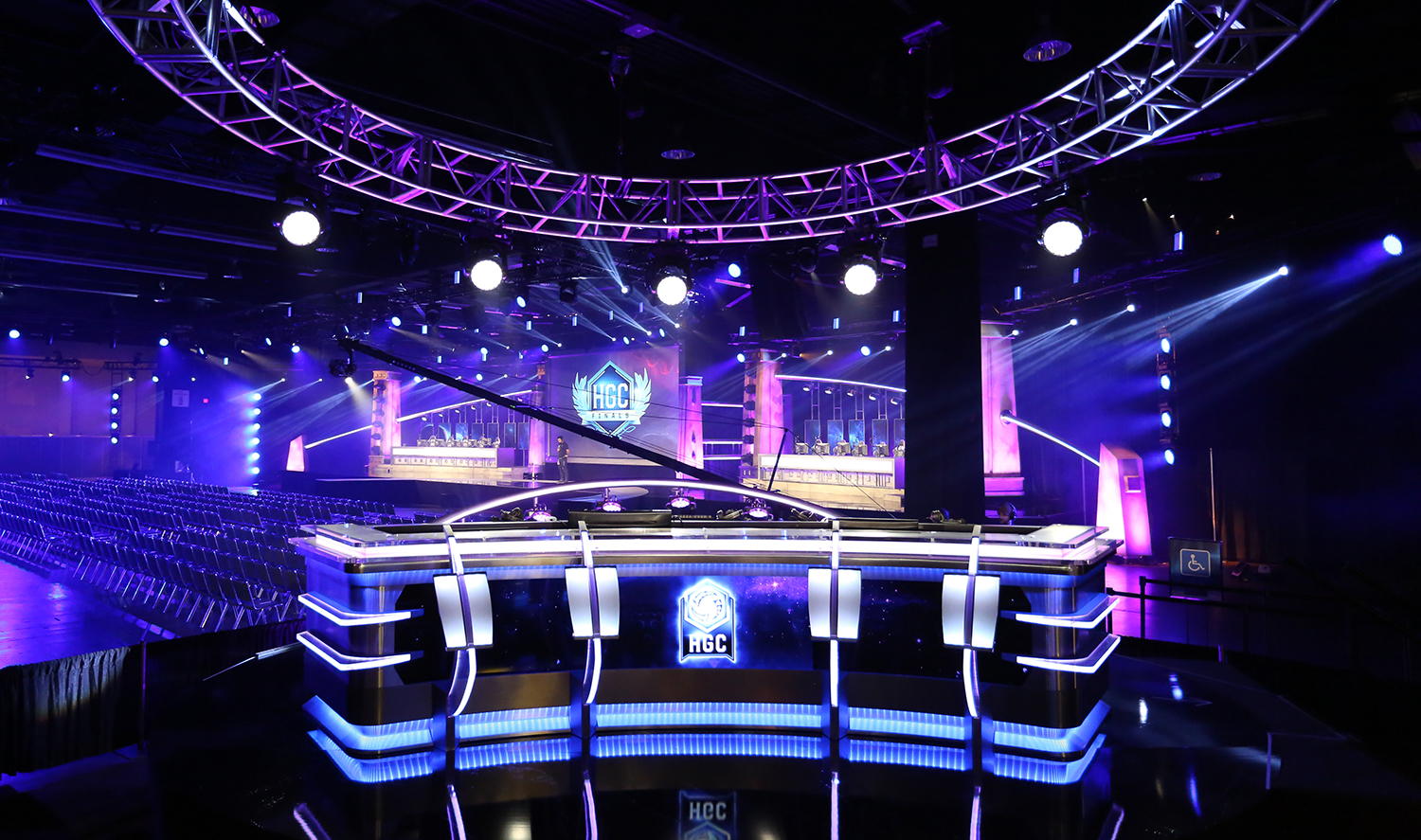BlizzCon Is Bigger Than Ever With Nine Stages, 12 Trucks, 200+ Broadcast Streams
The live stages feed into central Master Control, ‘Post Hub’
Story Highlights
With 40,000 fans onsite watching five live esports stages and four content stages sprawled across a million square feet at Anaheim Convention Center, it simply doesn’t get any bigger for the Blizzard Entertainment production operation than BlizzCon. In addition, Blizzard’s Global Broadcast team is distributing a whopping 211 unique broadcast streams to 17 outlets in 18 languages.
“For us, the live event and the broadcasts are very linked together because so much of the broadcast is from these live stages. Our show is definitely bigger this year,” says Pete Emminger, senior director, Blizzard Entertainment. “We’re really lucky in that we have a lot of consistent crew, so this year has actually been the smoothest year so far. Plus, we’ve really had a great year at Blizzard overall, so we’re extremely excited to finally be here at BlizzCon, which is really a celebration for us as much as it is [for the fans].”
A Blizzard of Activity: A Dozen Mobile Units Onsite Serving Nine Stages
Now in its 14th year, the convention features everything from live esports competitions to Q&A panels and announcements to demos of upcoming game releases to concerts and much more.
Blizzard’s Global Broadcast team has a dozen mobile units (including A and B units) and two flypacks onsite to serve the cavalcade of stages in Anaheim – with all shows feeding into a central Master Control and a new “Post Hub” operation.
“The way we have it set up, every content stage and esports stage is a separate production unit,” says Emminger. “All of that comes together in our Master Control at BlizzCon, which [handles] routing and distribution of live signals between all of the stages.”
BlizzCon’s five esports stages are Hearthstone (handled by Lyon Video Lyon 11), Heroes of the Storm (Clark Media’s 4K-capable Goliath), the Overwatch World Cup (NEP’s HDR-capable ND6 for the main production and BT-1 for the observer room), StarCraft II (NEP’s 4K-capable Atlas A and B units), and World of Warcraft (NEP TS2 A and B).
Of the four content stages, Mythic Stage (the “main stage”) is handled by NEP’s Denali Gold A and ST-79 and All Access Channel is produced out of by Dome 4K with a B unit. Legendary and Epic Stages are produced via flypack because of their location on the second floor of the convention center.
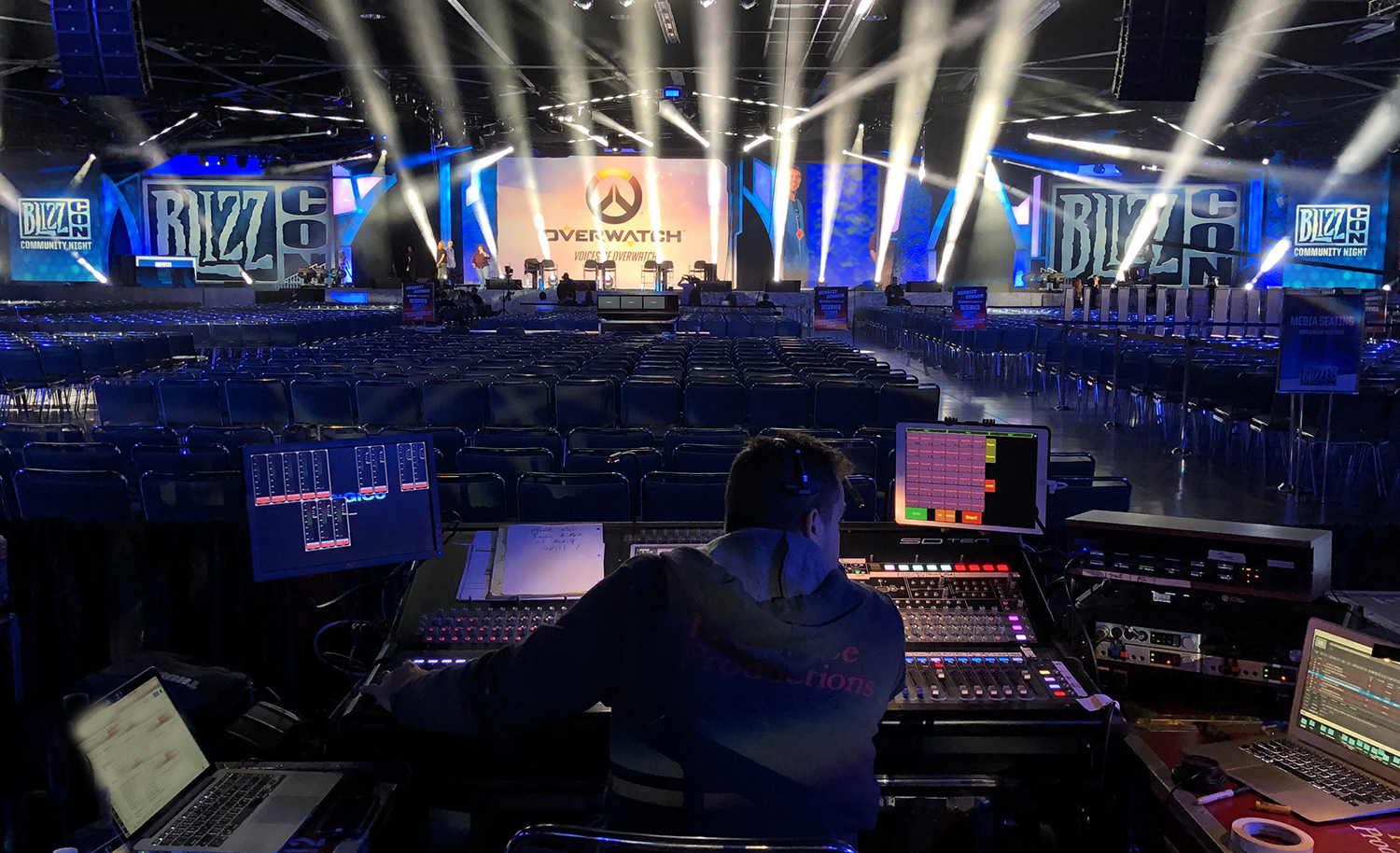 All feeds lead to the master-control operation, which is built around an Imagine Communications Platinum router (200×176, eight multiviewers) with 40 AJA FS2 frame sync/converters. A Ross Video Ultrix router (128×128) feeds the Spider X80 multiviewer video processer and seven LED destinations. In addition, 10 media servers feed all the LED elements and programs, and nine discrete IPTV channels (using Exterity) are distributed to LED walls throughout the convention center so that fans can watch stages from wherever they are. Master control also features a DiGiCo SD10 audio console (64×24).
All feeds lead to the master-control operation, which is built around an Imagine Communications Platinum router (200×176, eight multiviewers) with 40 AJA FS2 frame sync/converters. A Ross Video Ultrix router (128×128) feeds the Spider X80 multiviewer video processer and seven LED destinations. In addition, 10 media servers feed all the LED elements and programs, and nine discrete IPTV channels (using Exterity) are distributed to LED walls throughout the convention center so that fans can watch stages from wherever they are. Master control also features a DiGiCo SD10 audio console (64×24).
“In addition to [routing and signal distribution for the stages], Master Control is [managing] all of our broadcasts,” says Emminger. “So we do final QC work on audio and lighting there, as well as all of our transmission operations. And then we have all of our key platform partners —both internal like BlizzCon.com and external like Twitch — with us in Master Control. That way, everything from a signal acquisition and an output perspective can all be managed from one place.”
Debut of Post Hub: Postproduction Centralized in Anaheim
The most significant new addition from an infrastructure standpoint this year is the debut of a Post Hub operation.
“[In the past], all the different stages did all their own post, and we actually still had PAs running drives between all these trucks,” says Emminger. “So, this year, we knew we needed to build a dedicated Post Hub.”
Blizzard brought in a colossal 500-TB OpenDrives NAS for the edit/post team to fill throughout the weekend (although Emminger expects it to be roughly two-thirds full by weekend’s end). The NAS is broken into two: an OpenDrives Apex all flash NAS for edit and OpenDrives Summit hybrid NVME NAS for archive. Records are all done via EVS XT3 and IPDirector with EVS operators clipping from a total of 30 channels via seven trucks. The Post Hub operation comprises eight editors, two EVS operators, five MAM ops, and three CMS ops (which manage all content to BlizzCon.com).
“We realize 500 TB is pretty substantial for a single weekend show,” says Emminger. “But, considering the amount of [content] we create at BlizzCon, we felt it was appropriate.”
Inside the Convention Center: A Feast for the Eyes
With nine stages and a host of other activities, it’s no surprise that Blizzard’s camera complement is massive, comprising more than 50 broadcast cameras (a mix of Sony HDC-4300’s, Grass Valley LDX86’s, and Sony HDC-2500’s), six robos, and a multitude of miniature POV cameras (primarily Blackmagic Design 4K MicroUltra and Marshall 3G systems) deployed across the various stages.
“Our All Access channel is a fairly static news-focused show,” notes Emminger. “It has a few monitors in the set in the background, but it’s really intended to focus on the content itself. That’s where we do most of our key interviews.”
All five esports stages feature plenty of the high-tech aesthetics fans have come to expect from Blizzard. The Overwatch World Cup stage, for example, features a large overhead LED display similar to a center-hung arena scoreboard with a four-sided view. The StarCraft stage has host of Versa TUBE lighting products and LED strips integrated into the set, which are all fully reactive to elements in the game environment.
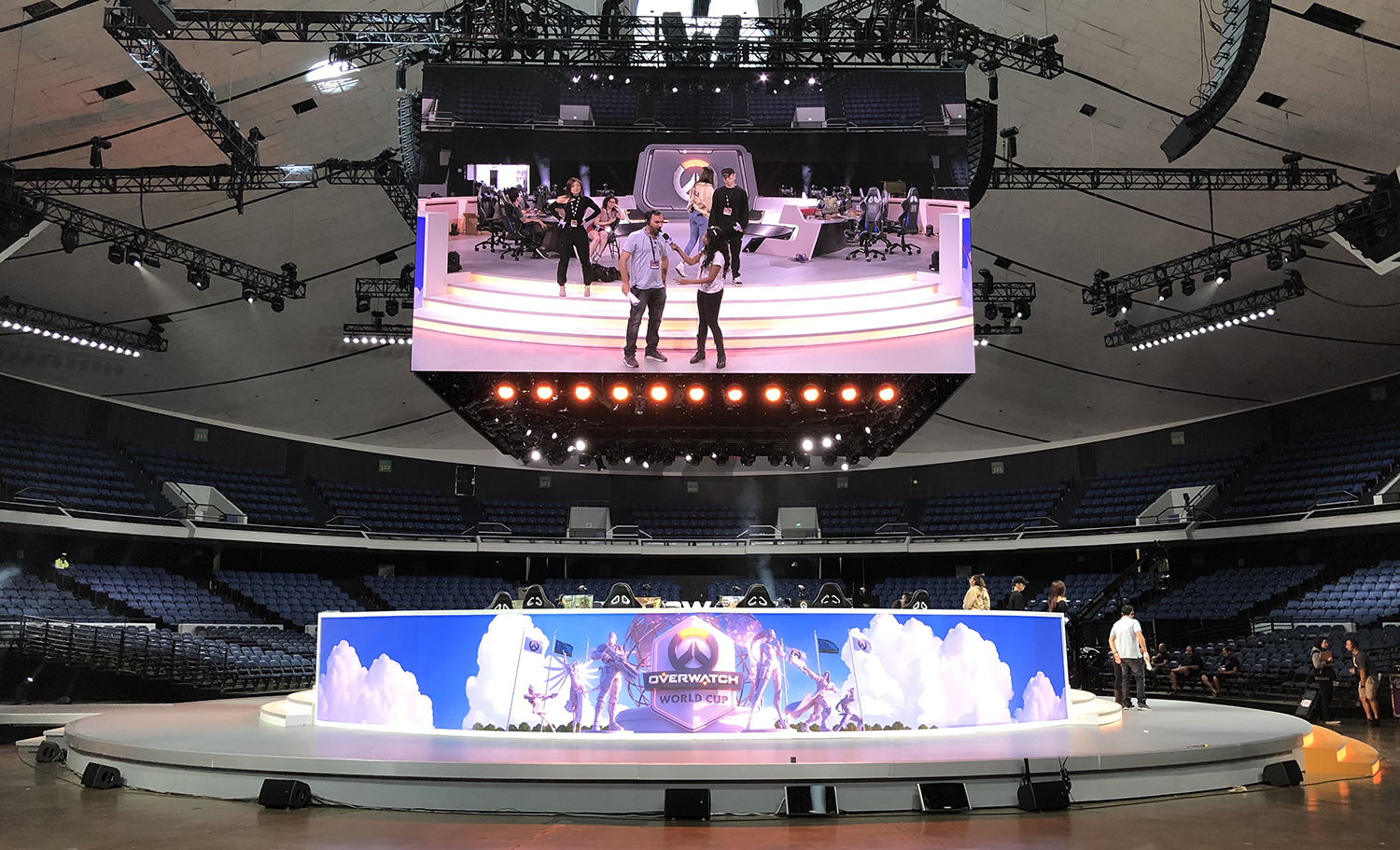
The Overwatch World Cup stage features a large overhead LED display similar to a center-hung arena scoreboard with a four-sided view.
The BlizzCon Opening Ceremony, which took place earlier today was centered at the Mythic stage but was also integrated live content feeds from all other stages.
“[The Opening Ceremony] is where the Master Control infrastructure really helps us a lot because we can basically route from any stage to any stage everything from comms to video to audio.” says Emminger. “We basically use the other stages like remotes for each other.”
In addition to the stages, Blizzard has established several streamer stations at live demo areas, where fans can preview upcoming game releases. Blizzard is also streaming press conferences (winners and losers) from all the esports stages and supporting its network partners that are onsite, including ESPN, which will produce preshow telecast leading up to the Overwatch World Cup.
The Blizzard social-media and digital teams are also out in full force at the convention center, creating text-, audio-, and video-based content
Beyond the Convention Center: Irvine, Austin, Burbank
Although the onsite operation is plenty complex, Blizzard Entertainment is also leveraging its Operations Center in Irvine, CA, and its facility in Austin, TX, to support BlizzCon. The Ops Center is managing all Blizzard core infrastructure — from game servers to the fiber backbone — while Austin serves as the customer-service operation to monitor stream quality monitoring for end-user perspective, as well as chat moderation (a key component in esports).
In addition, Blizzard Arena in Burbank, CA, hosted BlizzCon Opening Week (Oct. 25-29), which kicked off the festivities prior to the main event. In addition to using its main stage (Stage 1) for the Heroes Global Championship (HGC) and WoW Arena World Championship, Blizzard Arena hosted its first open-to-the-public esports competition on its secondary stage (Stage 5) with the StarCraft II World Championship Series (WCS).
“Having a stage open to the public kind of presented some production challenges that we typically don’t have,” says Emminger. “Overall, it went very smoothly, but it was definitely an extremely busy week at Blizzard Arena.”
Transmission Heads to Cloud, as Distribution Outlets Grow
Blizzard has also switched up its transmission scheme this year for BlizzCon, building out a cloud-based transmission pipeline within AWS Media Services to serve a whopping 422 endpoints (primary/backup).
“One of the biggest changes this year is, we’ve shifted a lot of our transmission platform to AWS,” notes Emminger. “They’ve been a really good partner with us. We have built out our own tech stack, which is heavily [integrated] with AWS but not exclusively. That is supporting all of our programs right now.”
Blizzard has established redundant contribution paths using The Switch (via private peer to AWS) and over the public internet via Zixi (with east/west regional redundant instant failover). The operation encompasses 18 SDI Sources and 78 Elemental Cloud Nodes and uses DMG 4200 Sencore and ATEME Titan encoders for contribution. Blizzard also has full telemetry and analytics capability through IneoQuest (by Telestream), Amazon Cloud Watch, and Zixi.
On the distribution side, Blizzard is delivering 211 unique broadcast streams from BlizzCon; some are free, and some are incorporated into the BlizzCon Virtual Ticket paywalled product. This year’s distribution partners are BlizzCon.com, Twitch, Snapchat, Facebook, Twitter, Openrec.tv, MLG.com, DisneyXD, ESPN3, AfreecaTV, cc.163.com, Zhanqi, Panda.tv, VK.com, Mixer, AB Group (France), and Hoyts theater chain (Australia).
“We distribute to a huge number amount of platforms and we also localize in 18 different languages,” says Emminger. “All of our esports programming is free, and we make the decision what goes on BlizzCon Virtual Ticket holistically across Blizzard [based on] what we feel our community would want access to.”
